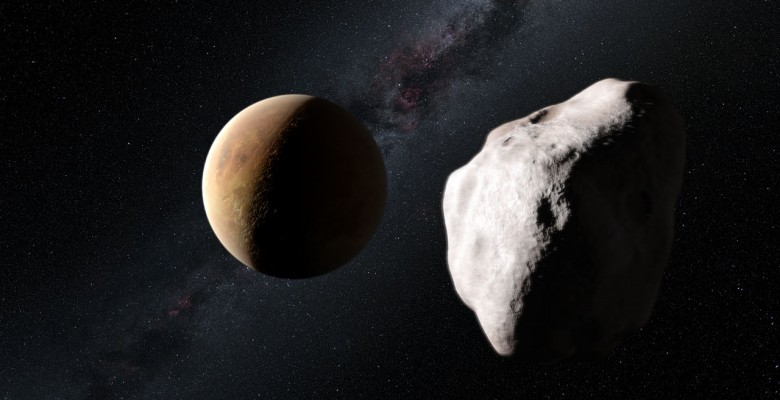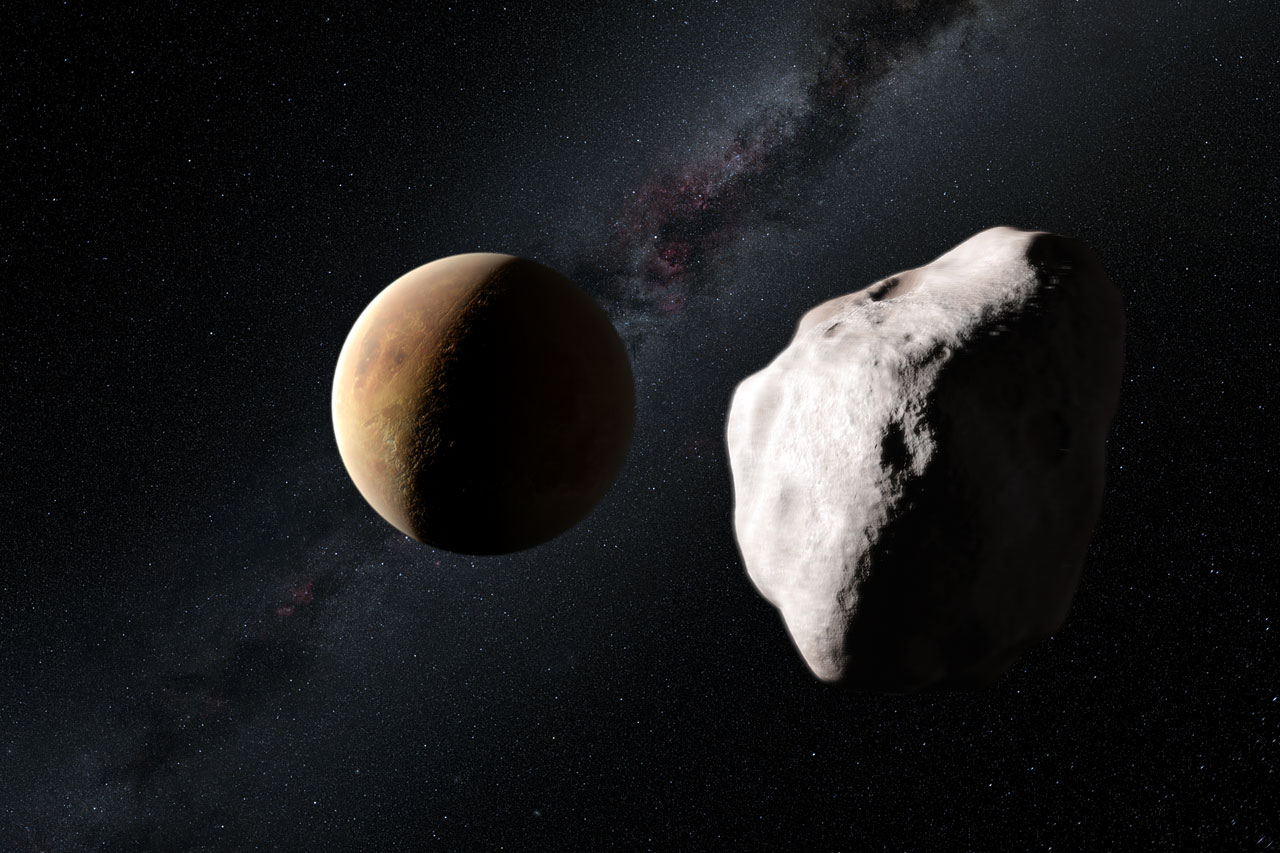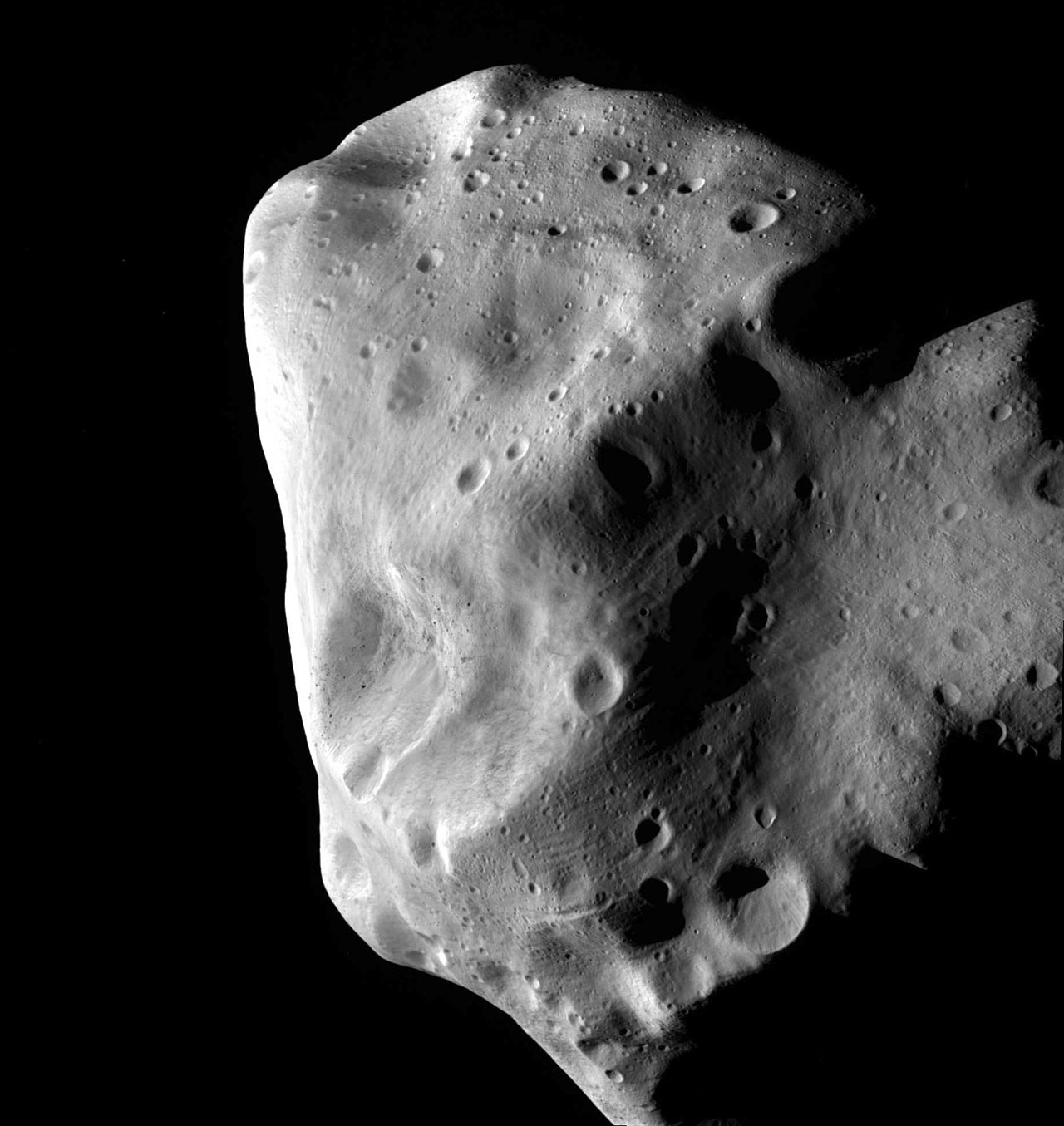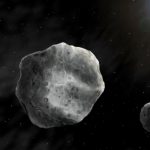
Press Release published on November 11 2011 by ESO
New observations indicate that the asteroid Lutetia is a leftover fragment of the same original material that formed the Earth, Venus and Mercury. Astronomers have combined data from ESA’s Rosetta spacecraft, ESO’s New Technology Telescope, and NASA telescopes. They found that the properties of the asteroid closely match those of a rare kind of meteorites found on Earth and thought to have formed in the inner parts of the Solar System. Lutetia must, at some point, have moved out to its current location in the main asteroid belt between Mars and Jupiter.
This artist’s impression shows an event in the early history of the Solar System that may explain how the unusual asteroid Lutetia came to now be located in the main asteroid belt, between Mars and Jupiter. Lutetia is seen passing close to one of the very young rocky planets about four billion years ago and having its orbit drastically altered. Its unusual spectral properties indicate that Lutetia started life as a fragment of the material that was forming the inner planets but it is now found to be an interloper much further from the Sun.
Credit: ESO/M. Kornmesser and Nick Risinger
A team of astronomers from French and North American universities have studied the unusual asteroid Lutetia in detail at a very wide range of wavelengths [1] to deduce its composition. Data from the OSIRIS camera on ESA’s Rosetta spacecraft [2], ESO’s New Technology Telescope (NTT) at the La Silla Observatory in Chile, and NASA’s Infrared Telescope Facility in Hawaii and Spitzer Space Telescope were combined to create the most complete spectrum of an asteroid ever assembled [3].
This spectrum of Lutetia was then compared with that of meteorites found on Earth that have been extensively studied in the laboratory. Only one type of meteorite — enstatite chondrites— was found to have properties that matched Lutetia over the full range of colours.
Enstatite chondrites are known to be material that dates from the early Solar System. They are thought to have formed close to the young Sun and to have been a major building block in the formation of the rocky planets [4], in particular the Earth, Venus and Mercury[5]. Lutetia seems to have originated not in the main belt of asteroids, where it is now, but much closer to the Sun.
“But how did Lutetia escape from the inner Solar System and reach the main asteroid belt?” asks Pierre Vernazza (ESO), the lead author of the paper.
Astronomers have estimated that less than 2% of the bodies located in the region where Earth formed, ended up in the main asteroid belt. Most of the bodies of the inner Solar System disappeared after a few million years as they were incorporated into the young planets that were forming. However, some of the largest, with diameters of about 100 kilometres or more, were ejected to safer orbits further from the Sun.
Lutetia, which is about 100 kilometres across, may have been tossed out from the inner parts of the young Solar System if it passed close to one of the rocky planets and thus had its orbit dramatically altered [6]. An encounter with the young Jupiter during its migration to its current orbit could also account for the huge change in Lutetia’s orbit [7].
“We think that such an ejection must have happened to Lutetia. It ended up as an interloper in the main asteroid belt and it has been preserved there for four billion years,” continues Pierre Vernazza.
Earlier studies of its colour and surface properties showed that Lutetia is a very unusual and rather mysterious member of the asteroid main belt. Previous surveys have shown that similar asteroids are very rare and represent less than 1% of the asteroid population of the main belt. The new findings explain why Lutetia is different — it is a very rare survivor of the original material that formed the rocky planets.
“Lutetia seems to be the largest, and one of the very few, remnants of such material in the main asteroid belt. For this reason, asteroids like Lutetia represent ideal targets for future sample return missions. We could then study in detail the origin of the rocky planets, including our Earth,” concludes Pierre Vernazza.
This image of the unusual asteroid Lutetia was taken by ESA’s Rosetta probe during its closest approach in July 2010. Lutetia, which is about 100 kilometres across, seems to be a leftover fragment of the same original material that formed the Earth, Venus and Mercury. It is now part of the main asteroid belt, between the orbits of Mars and Jupiter, but its composition suggests that it was originally much closer to the Sun.
Credit: ESA 2010 MPS for OSIRIS Team MPS/UPD/LAM/IAA/RSSD/INTA/UPM/DASP/IDA
Notes
[1] The electromagnetic spectrum represents the complete range of wavelengths covered by the different types ofelectromagnetic radiation. Visible light is the most familiar form, but many others exist. Many of these types of radiation are used in everyday life, such as radio waves, microwaves, infrared and ultraviolet light and X-rays.
[2] The Rosetta spacecraft, on its way to comet 67P/Churyumov-Gerasimenko, flew past Lutetia on 10 July 2010.
[3] Rosetta’s OSIRIS camera provided data in the ultraviolet, ESO’s NTT provided data in visible light, while NASA’s Infrared Telescope Facility in Hawaii and Spitzer Space Telescope provided data in the near-infrared and mid-infrared respectively.
[4] The enstatite chondrites (E chondrites) are a unique class of meteorites that account for only about 2% of the recovered meteorite falls. The unusual mineralogy and chemistry of E chondrites is consistent with formation relatively close to the Sun. This is further supported by isotope measurements (verified for oxygen, nitrogen, ruthenium, chromium and titanium): E chondrites are the only groups of chondrites that have the same isotopic composition as the Earth and Moon system. This strongly suggests that the Earth formed from enstatite chondrite-type materials and also that E chondrites formed at about the same distance from the Sun as the Earth.
In addition it has been recently shown that formation from enstatite chondrite bodies can explain Mercury’s unusual and previously inexplicable composition. This suggests that Mercury — like the Earth — largely accreted from enstatite chondrite-like materials.
[5] Although they all formed from similar material, it remains a mystery why the inner three planets are so different.
[6] This process is very much like the gravitational assist methods used to change the direction and speed of space probes by arranging for them to fly close to a planet.
[7] Some astronomers think that the gaseous giant may have been closer to the Sun in the early days of the Solar System, before moving outwards to its current position. This would have caused havoc in the orbits of other objects of the inner Solar System due to the huge gravitational pull of Jupiter.
More information
This research was presented in a paper, “Asteroid (21) Lutetia as a remnant of Earth’s precursor planetesimals”, to appear in the journal Icarus.
The team is composed of P. Vernazza (Laboratoire d’Astrophysique de Marseille (LAM), France; European Southern Observatory, Germany), P. Lamy (LAM, France), O. Groussin (LAM, France), T. Hiroi (Department of Geological Sciences, Brown University, USA), L. Jorda(LAM, France), P.L. King (Institute for Meteoritics, University of New Mexico, USA), M.R.M. Izawa (Department of Earth Sciences, University of Western Ontario, Canada), F. Marchis (Carl Sagan Center at the SETI Institute, USA; IMCCE, Observatoire de Paris (OBSPM), France), M. Birlan (IMCCE, OBSPM, France), R. Brunetto (Institut d’Astrophysique Spatiale, CNRS, France).
ESO, the European Southern Observatory, is the foremost intergovernmental astronomy organisation in Europe and the world’s most productive astronomical observatory. It is supported by 15 countries: Austria, Belgium, Brazil, the Czech Republic, Denmark, France, Finland, Germany, Italy, the Netherlands, Portugal, Spain, Sweden, Switzerland and the United Kingdom. ESO carries out an ambitious programme focused on the design, construction and operation of powerful ground-based observing facilities enabling astronomers to make important scientific discoveries. ESO also plays a leading role in promoting and organising cooperation in astronomical research. ESO operates three unique world-class observing sites in Chile: La Silla, Paranal and Chajnantor. At Paranal, ESO operates the Very Large Telescope, the world’s most advanced visible-light astronomical observatory and two survey telescopes. VISTA works in the infrared and is the world’s largest survey telescope and the VLT Survey Telescope is the largest telescope designed to exclusively survey the skies in visible light. ESO is the European partner of a revolutionary astronomical telescope ALMA, the largest astronomical project in existence. ESO is currently planning a 40-metre-class European Extremely Large optical/near-infrared Telescope, the E-ELT, which will become “the world’s biggest eye on the sky”.
Links
Contacts
Pierre Vernazza
ESO, Astronomer
Garching bei München,, Germany
Email: pvernazz@eso.org
Philippe Lamy
Laboratoire d’Astrophysique de Marseille, Directeur de Recherche
Marseille, France
Tel: +33 49 105 5932
Email: philippe.lamy@oamp.fr
Richard Hook
ESO, La Silla, Paranal, E-ELT & Survey Telescopes Press Officer
Garching bei München, Germany
Tel: +49 89 3200 6655
Cell: +49 151 1537 3591
Email: rhook@eso.org



